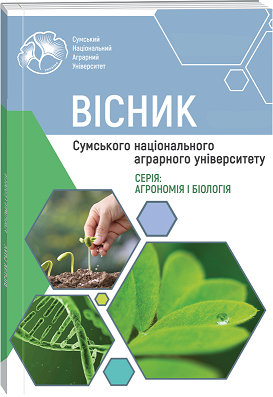НАКОПИЧЕННЯ ВАЖКИХ МЕТАЛІВ У ПРОРОСТКАХ СОНЯШНИКУ ПІД ВПЛИВОМ КАДМІЄВОГО СТЕСУ
Анотація
Стійкою тенденцією останніх десятиліть є стрімке зростання забруднення грунту важкими металами. Особливу небезпеку становлять метали, які не відіграють суттєвої ролі у житті рослин, але можуть накопичуватися у рослинах та мігрувати харчовим ланцюгом. Одним із таких елементів є кадмій, період напіввиведення якого з організму людини складає більше 50 років. Для селекційних програм, спрямованих на створення сортів із низьким рівнем накопичення кадмію, важливим є розуміння ролі генотипу в процесах надходження металу до різних частин рослин. Дослідження проводились на селекційних зразках соняшнику, виділених за методикою вегетаційного оцінювання в Сумському НАУ в 2018 році. За результатами оцінювання лінія 62\3 характеризувалася низьким, а лінія JB231AC – високим рівнем стійкості до накопичення кадмію. У 2020 році насіння зразків було пересіяно в умовах Науково-технологічного інституту м. Хенань. Досліджували 20-денні проростки соняшнику, що вегетували у пластикових контейнерах з розчином Хогланда. Із рівномірно розвинених рослин було сформовано 4 вибірки, які протягом 7 днів знаходились у розчині CdCl2 • 2,5 H20 з концентрацією 0; 25; 50 та 100 мкМ. Для аналізу зразки розчиняли у нітратній кислоті. Визначення вмісту металів проводили на атомно-адсорбційному спектрофотометрі (ICP-OES, Optima 2100DV, Perkin Elmer). В обох зразків було відмічено стійкий тренд до зменшення висоти рослин та загальної маси проростків із збільшенням концентрації кадмію. Різниця між зразками за згаданими показниками нівелювалася при концентрації 50 і більше мкМ. У випадку із висушеними частинами рослин статистично суттєвий вплив кадмію виявлено при концентрації 50 і більше мкМ для показника маси сухої речовини коренів та при концентрації 100 мкМ для показника маси надземної частини. Встановлено, що пороговою концентрацією, яка забезпечувала суттєву різниці між показниками вмісту кадмію в коренях та стеблах, було 100 мкМ. Порівняно із зразком JB231AC, зразок 64\2 мав вищий вміст кадмію у коренях на 23 % та на 12 % у надземній частині. Відносно Li, Nі, та Sr суттєва різниця між зразками здебільшого спостерігалася за концентрації 25 та 50 мкМ. Накопичення і розподіл кадмію в рослинах мають значний зв’язок з видами, сортами, частинами та середовищем вирощування і в кінцевому підсумку призводять до різного накопичення та розподілу в різних частинах рослин. Встановлено зворотну залежність між концентрацією кадмію та концентраціями літію та нікелю, що може бути зумовлено генотипними особливостями, але не виключається наявність антагонізму між накопиченням цих металів. Однак таке твердження потребує додаткових досліджень. Загалом дослідження підтвердили достатній рівень ефективності вегетативної оцінки вихідного матеріалу соняшнику на стійкість до накопичення кадмію та стабільність цієї ознаки в наступних поколіннях.
Посилання
2. Alaboudi, K. A., Ahmed, B., & Brodie, G. (2018). Phytoremediation of Pb and Cd contaminated soils by using sunflower (Helianthus annuus) plant. Annals of Agricultural Sciences, 63(1),123–127.
3. Aristide, Y. Y. H., Valery, A. D. P., Chantal, K. A. L., Brou, D., & Kouame, D. B. (2021). Assessment of the Health Risks Associated with the Ingestion of Heavy Metals (As, Cd, Cr, Pb, Ni, Zn, Hg) in Vegetable Crops in the City of Daloa (Ivory Coast). American Journal of Applied Chemistry, 9(4).
4. Bán, R., Kovács, A., Nisha, N., Pálinkás, Z., Zalai, M., Yousif, A. I. A., & Körösi, K. (2021). New and High Virulent Pathotypes of Sunflower Downy Mildew (Plasmopara halstedii) in Seven Countries in Europe. J Fungi (Basel), 7(7), 549–549. doi: 10.3390/jof7070549
5. Bashir, S., Qayyum, M. A., Husain, A., Bakhsh, A., Ahmed, N., Hussain, M. B., Elshikh, M. S., Alwahibi, M. S., Almunqedhi, B. M. A., Hussain, R., Wang, Y. F., Zhou, Y., & Diao, Z. H. (2021). Efficiency of different types of biochars to mitigate Cd stress and growth of sunflower (Helianthus L.) in wastewater irrigated agricultural soil. Saudi J Biol Sci, 28, 2453–2459.
6. Belhaj, D., Elloumi, N., Jerbi, B., Zouari, M., Abdallah, F. B., Ayadi, H., & Kallel, M. (2016). Effects of sewage sludge fertilizer on heavy metal accumulation and consequent responses of sunflower (Helianthus annuus). Environ Sci Pollut Res Int, 23, 20168–20177. doi: 10.1007/s11356-016-7193-0
7. Chen, F., Wang, F., Wu, F., Mao, W., Zhang, G., & Zhou, M. (2010). Modulation of exogenous glutathione in antioxidant defense system against Cd stress in the two barley genotypes differing in Cd tolerance. Plant Physiol Biochem, 48, 663–672. doi: 10.1016/j.plaphy.2010.05.001
8. Chen, Y. P., Chen, D., & Liu, Q. (2017). Exposure to a magnetic field or laser radiation ameliorates effects of Pb and Cd on physiology and growth of young wheat seedlings. J Photochem Photobiol B 169, 171-177. https://doi.org/10.1016/j.jphotobiol.2017.03.012.
9. Cornu, J. Y., Bakoto, R., Bonnard, O., Bussière, S., Coriou, C., Sirguey, C., Sterckeman, T., Thunot, S., Visse, M. I., & Nguyen, C. (2016). Cadmium uptake and partitioning during the vegetative growth of sunflower exposed to low Cd concentrations in hydroponics. Plant and Soil, 404(1–2), 263–275. Doi: 10.1007/s11104-016-2839-8
10. Cornu, J. Y., Bussière, S., Coriou, C., Robert, T., Maucourt, M., Deborde, C., Moing, A., & Nguyen, C. (2020). Changes in plant growth, Cd partitioning and xylem sap composition in two sunflower cultivars exposed to low Cd concentrations in hydroponics. Ecotoxicol Environ Saf, 205, 111145. doi: 10.1016/j.ecoenv.2020.111145
11. Dakak, R. A. E., & Hassan, I. A. (2020). The Alleviative Effects of Salicylic Acid on Physiological Indices and Defense Mechanisms of Maize (Zea Mays L. Giza 2) Stressed with Cadmium. Environmental Processes: An International Journal, 7. (3),873–884. doi: 10.1007/s40710-020-00448-1
12. Fan, J. L., Wei, X. Z., Wan, L. C., Zhang, L. Y., Zhao, X. Q., Liu, W. Z., Hao, H. Q., & Zhang, H. Y. (2011). Disarrangement of actin filaments and Ca²⁺ gradient by CdCl₂ alters cell wall construction in Arabidopsis thaliana root hairs by inhibiting vesicular trafficking. J Plant Physiol, 168, 1157–1167. doi: 10.1016/j.jplph.2011.01.031
13. Han, Y., Wu, M., Hao, L., & Yi, H. (2018). Sulfur dioxide derivatives alleviate cadmium toxicity by enhancing antioxidant defence and reducing Cd(2+) uptake and translocation in foxtail millet seedlings. Ecotoxicol Environ Saf, 157, 207–215. doi: 10.1016/j.ecoenv.2018.03.084
14. Hawrylak-Nowak, B., Dresler, S., & Matraszek, R. (2015). Exogenous malic and acetic acids reduce cadmium phytotoxicity and enhance cadmium accumulation in roots of sunflower plants. Plant Physiol Biochem, 94, 225–234. doi: 10.1016/j.plaphy.2015.06.012
15. Issam, S., Wahbi, D., & Yacine, C. (2015). Selenium Treatment Alleviated Oxidative Alteration Generated by Cadmium in Sunflower Roots. British Biotechnology Journal, 5(4). doi: 10.9734/BBJ/2015/14802
16. Jaouani, K., Karmous, I., Ostrowski, M., Ferjani, E. E., Jakubowska, A., & Chaoui, A. (2018). Cadmium effects on embryo growth of pea seeds during germination: Investigation of the mechanisms of interference of the heavy metal with protein mobilization-related factors. J Plant Physiol, 226, 64–76. doi: 10.1016/j.jplph.2018.02.009
17. Jarrah, M., Ghasemi-fasaei, R., Ronaghi, A., Zarei, M., & Mayel, S. (2019). Enhanced Ni phytoextraction by effectiveness of chemical and biological amendments in sunflower plant grown in Ni-polluted soils. Chemistry and Ecology, 35(8),732–745.
18. Khadija, J., Inès, K., Maciej, O., Ezzedine El, F., Anna, J., & Abdelilah, C. (2018). Cadmium effects on embryo growth of pea seeds during germination: Investigation of the mechanisms of interference of the heavy metal with protein mobilization-related factors. Journal of Plant Physiology, 226, 64–76. doi: 10.1080/02757540.2019.1644325
19. Li, Q., Wang, G., Wang, Y., Dan, Y., Guan, C., & Ji, J. (2019). Foliar application of salicylic acid alleviate the cadmium toxicity by modulation the reactive oxygen species in potato. Ecotoxicol Environ Saf, 172, 317–325. doi: 10.1016/j.ecoenv.2019.01.078.
20. Li, X., Zhang, L., Li, Y., Ma, L., Ning, B., & Ma, C. (2012). Changes in photosynthesis, antioxidant enzymes and lipid peroxidation in soybean seedlings exposed to UV-B radiation and/or Cd. Plant and Soil, 352, 377–387. doi: 10.1007/s11104-011-1003-8
21. Mahardika, G., Rinanti, A., & Fachrul, M. F. (2018). Phytoremediation of heavy metal copper (Cu2+) by sunflower (Helianthus annuus L.). IOP Conference Series: Earth and Environmental Science, 106. doi: 10.1088/1755-1315/106/1/012120
22. Maria Celeste, D., Cristina, M., José, M.-P., Carlos, C., Berta, G., & Conceição, S. (2013). Cadmium toxicity affects photosynthesis and plant growth at different levels. Acta Physiologiae Plantarum, 35, 1281–1289. doi: 10.1007/s11738-012-1167-8
23. Prerna, S., Indra, S. & Kavita, S. (2020). Alterations in antioxidative machinery and growth parameters upon application of nitric oxide donor that reduces detrimental effects of cadmium in rice seedlings with increasing days of growth. South African Journal of Botany, 131(C),283–294. doi: 10.1016/j.sajb.2020.02.022
24. Reyes-Hinojosa, D., Lozada-Pérez, C. A., Zamudio Cuevas, Y., López-Reyes, A., Martínez-Nava, G., Fernández-Torres, J., Olivos-Meza, A., L&a-Solis, C., Gutiérrez-Ruiz, M. C., Rojas Del Castillo, E., & Martínez-Flores, K. (2019). Toxicity of cadmium in musculoskeletal diseases. Environ Toxicol Pharmacol, 72, 103219. doi: 10.1016/j.etap.2019.103219
25. Robert, M., & Stengel, P. (1999). Soils and agriculture: soil resource, quality and degradation processes. A world, European and French prospect. Cahiers Detudes Et De Recherches Francophones Agricultures, 8, 301–308.
26. Silveira, R. l. F. Í. H., Jos, L., Arajo, P. F. í., & Ferracci, A. L. S. R. (2021). Photosynthetic Parameters and Growth of Rice, Lettuce, Sunflower and Tomato in an Entisol as Affected by Soil Acidity and Bioaccumulation of Ba, Cd, Cu, Ni, and Zn. Archives of environmental contamination and toxicology. doi: 10.1007/s00244-021-00850-2
27. Singh, A., & Prasad, S. M. (2014). Effect of agro-industrial waste amendment on Cd uptake in Amaranthus caudatus grown under contaminated soil: an oxidative biomarker response. Ecotoxicol Environ Saf, 100, 105–113. doi: 10.1016/j. ecoenv.2013.09.005.
28. Templeton, D. M., & Liu, Y. (2010). Multiple roles of cadmium in cell death and survival. Chem Biol Interact, 188, 267–275. doi: 10.1016/j.cbi.2010.03.040
29. Zaichick, V. & Zaichick, S. (2014). Relations of the Al, B, Ba, Br, Ca, Cl, Cu, Fe, K, Li, Mg, Mn, Na, P, S, Si, Sr, and Zn mass fractions to morphometric parameters in pediatric and nonhyperplastic young adult prostate glands. Biometals: an international journal on the role of metal ions in biology, biochemistry, and medicine, 27(2), 333–348. doi: 10.1007/s10534-014-9716-9
30. Wang, C., Zhang, Y., Liu, Y., Xu, H., Zhang, T., Hu, Z., Lou, L., & Cai, Q. (2020). Ectopic expression of wheat aquaglyceroporin TaNIP2;1 alters arsenic accumulation and tolerance in Arabidopsis thaliana. Ecotoxicology and Environmental Safety, 205, 111131. doi: 10.1016/j.ecoenv.2020.111131
31. Wu, Z., Zhao, X., Sun, X., Tan, Q., Tang, Y., Nie, Z., Qu, C., Chen, Z., & Hu, C. (2015). Antioxidant enzyme systems and the ascorbate-glutathione cycle as contributing factors to cadmium accumulation and tolerance in two oilseed rape cultivars (Brassica napus L.) under moderate cadmium stress. Chemosphere, 138, 526–36. doi: 10.1016/j.chemosphere.2015.06.080
32. Yan, Y., Sun, Q., Yang, J., Zhang, X., & Guo, B. (2021). Source attributions of Cadmium contamination in rice grains by Cadmium isotope composition analysis: A field study. Ecotoxicol Environ Saf, 210, 111865. doi: 10.1016/j.ecoenv.2020.111865.
33. Zaichick, V., Zaichick, S., Karandashev, V., & Nosenko, S. (2009). The Effect of Age and Gender on Al, B, Ba, Ca, Cu, Fe, K, Li, Mg, Mn, Na, P, S, Sr, V, and Zn Contents in Rib Bone of Healthy Humans. Biological Trace Element Research, 129(1–3),107–115. doi: 10.1007/s12011-008-8302-9.
34. Zhou, J., Chen, L. H., Peng, L., Luo, S., & Zeng, Q. R. (2020). Phytoremediation of heavy metals under an oil crop rotation and treatment of biochar from contaminated biomass for safe use. Chemosphere, 247, 125856. doi: 10.1016/j.chemosphere.2020.125856
35. Marguí, E., Queralt, I. & Hidalgo, M (2009). Application of X-ray fluorescence spectrometry to determination and quantitation of metals in vegetal material. TrAC Trends in Analytical Chemistry, 28(3), 362–372. doi: 0.1016/j.trac.2008.11.011

 ISSN
ISSN  ISSN
ISSN 


